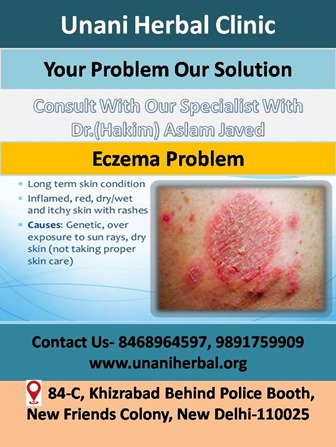Issue :- 88
What Are the 7 Different Types of Eczema?

7 types of eczema
If your skin itches and turns red from time to time, you might have eczema. This skin condition is very common in children, but adults can get it too.
Eczema is sometimes called atopic dermatitis, which is the most common form. “Atopic” refers to an allergy. People with eczema often have allergies or asthma along with itchy, red skin.
Eczema comes in a few other forms, too. Each eczema type has its own set of symptoms and triggers.
There are also some common symptoms for all types of eczema:
- dry, scaly skin
- redness
- itching, which may be intense

1. Atopic dermatitis
Atopic dermatitis is the most common form of eczema. It usually starts in childhood, and often gets milder or goes away by adulthood. Atopic dermatitis is part of what doctors call the atopic triad. “Triad” means three. The other two diseases in the triad are asthma and hay fever. Many people with atopic dermatitis have all three conditions.
Symptoms
In atopic dermatitis:
- the rash often forms in the creases of your elbows or knees
- skin in areas where the rash appears may turn lighter or darker, or get thicker
- small bumps may appear and leak fluid if you scratch them
- babies often get the rash on their scalp and cheeks
- your skin can get infected if you scratch it
Causes
Atopic dermatitis happens when your skin’s natural barrier against the elements is weakened. This means your skin is less able to protect you against irritants and allergens. Atopic dermatitis is likely caused by a combination of factors such as:
- genes
- dry skin
- an immune system problem
- triggers in the environment
2. Contact dermatitis
If you have red, irritated skin that’s caused by a reaction to substances you touch, you may have contact dermatitis. It comes in two types: Allergic contact dermatitisis an immune system reaction to an irritant like latex or metal.Irritant contact dermatitisstarts when a chemical or other substance irritates your skin.
Symptoms
In contact dermatitis:
- your skin itches, turns red, burns, and stin
- itchy bumps called hives may pop up on your skin
- fluid-filled blisters can form that may ooze and crust over
- over time, the skin may thicken and feel scaly or leathery
Causes
Contact dermatitis happens when you touch a substance that irritates your skin or causes an allergic reaction. The most common causes are:
- detergents
- bleach
- jewelry
- latex
- nickel
- paint
- poison ivy and other poisonous plants
- skin care products, including makeup
- soaps and perfumes
- solvents
- tobacco smoke
ADVERTISING
3. Dyshidrotic eczema
Dyshidrotic eczema causes small blisters to form on your hands and feet. It’s more common in women than men.
Symptoms
In dyshidrotic eczema:
- fluid-filled blisters form on your fingers, toes, palms, and soles of your feet
- these blisters may itch or hurt
- the skin can scale, crack, and flake
Causes
Dyshidrotic eczema can be caused by:
- allergies
- damp hands and feet
- exposure to substances such as nickel, cobalt, or chromium salt
- stress
4. Hand eczema
Eczema that only affects your hands is called hand eczema. You may get this type if you work in a job like hairdressing or cleaning, where you regularly use chemicals that irritate the skin.
Symptoms
In hand eczema:
- your hands get red, itchy, and dry
- they may form cracks or blisters
Causes
Hand eczemais triggered by exposure to chemicals. People who work in jobs that expose them to irritants are more likely to get this form, such as:
- cleaning
- hairdressing
- healthcare
5. Neurodermatitis
Neurodermatitis is similar to atopic dermatitis. It causes thick, scaly patches to pop up on your skin.
Symptoms
In neurodermatitis:
- thick, scaly patches form on your arms, legs, back of your neck, scalp, bottoms of your feet, backs of your hands, or genitals
- these patches can be very itchy, especially when you’re relaxed or asleep
- if you scratch the patches, they can bleed and get infected
Causes
Neurodermatitis usually starts in people who have other types of eczema or psoriasis. Doctors don’t know exactly what causes it, although stress can be a trigger.
6. Nummular eczema
This type of eczema causes round, coin-shaped spots to form on your skin. The word “nummular” means coin in Latin. Nummular eczema looks very different from other types of eczema, and it can itch a lot.
Symptoms
In nummular eczema:
- round, coin-shaped spots form on your skin
- the spots may itch or become scaly
Causes
Nummular eczemacan be triggered by a reaction to an insect bite, or by an allergic reaction to metals or chemicals. Dry skin can also cause it. You’re more likely to get this form if you have another type of eczema, such as atopic dermatitis.
7. Stasis dermatitis
Stasis dermatitis happens when fluid leaks out of weakened veins into your skin. This fluid causes swelling, redness, itching, and pain.
Symptoms
In stasis dermatitis:
- the lower part of your legs may swell up, especially during the day when you’ve been walking
- your legs may ache or feel heavy
- you’ll likely also have varicose veins, which are thick, ropey damaged veins in your legs
- the skin over those varicose veins will be dry and itchy
- you may develop open sores on your lower legs and on the tops of your feet
Causes
Stasis dermatitis happens in people who have blood flow problems in their lower legs. If the valves that normally push blood up through your legs toward your heart malfunction, blood can pool in your legs. Your legs can swell up and varicose veins can form.
Seeing a doctor
See your doctor if the itching and redness you’re experiencing doesn’t go away on its own, or if it interferes with your life. A skin doctor called a dermatologist can diagnose and treat eczema. If you don’t already have a dermatologist, our Healthline FindCare tool can help you connect to physicians in your area.
To help your doctor understand your condition, it may be helpful to keep a diary to identify your eczema triggers. Write down:
- what you eat and drink
- what skin products, chemicals, soaps, makeup, and detergents you use
- what activities you do, such as taking a walk outside in the woods or swimming in a chlorinated pool
- how long you spend in the bath or shower, and the temperature of the water
- when you’re under stress
You should begin to notice connections between your activities and your eczema flare-ups. Bring this journal to your doctor to help them pinpoint your triggers.
An allergy specialist can also do a patch test. This test places small amounts of irritating substances on patches that are applied to your skin. The patches stay on your skin for 20 to 30 minutes to see if you have a reaction. This test can help your doctor tell which substances trigger your eczema, so you can avoid them.

Nomination form for 2022 Global Awards
https://www.unaniherbal.org/nomination-form.html
For Consultation click here
Copyright 2014 Unani Herbal
If you wish to cancel your subscription to this newsletter click here





